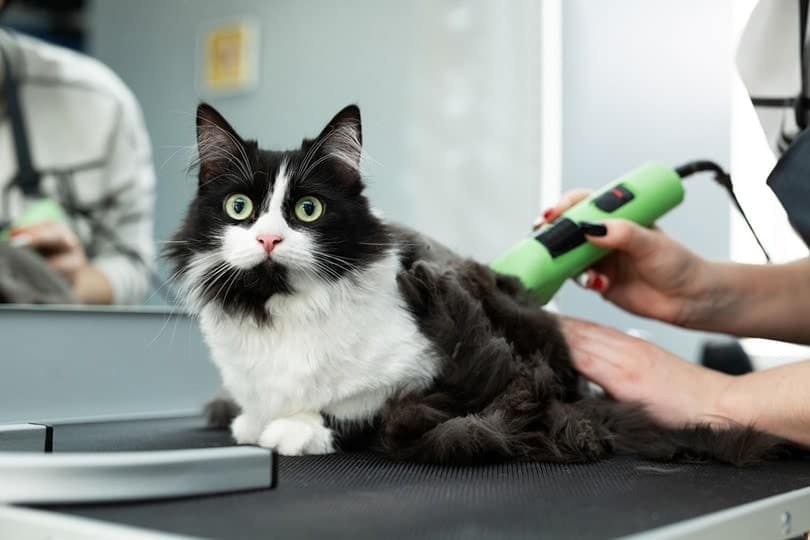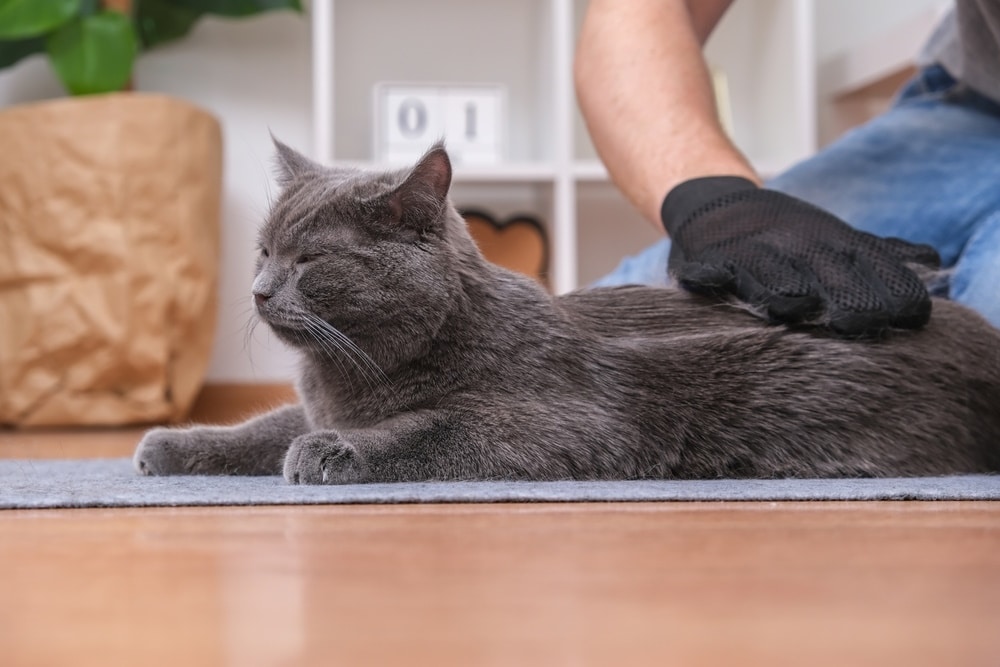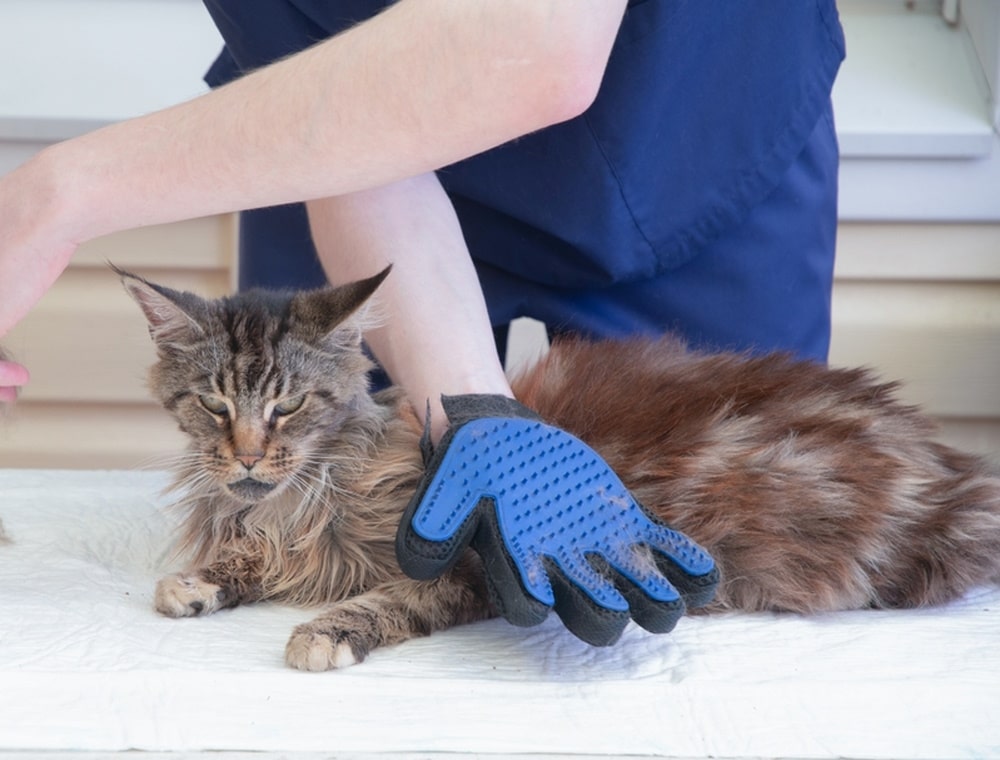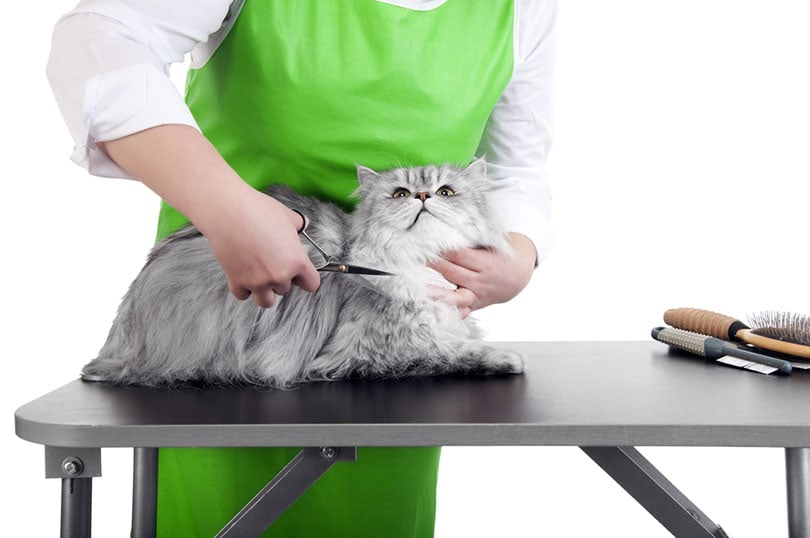Owners of long-haired cats will know the struggle of keeping their cat’s bottoms clean. Poop and debris can easily get caught in the surrounding hair and be challenging to maintain. The remnants of dried poop not only look unsightly but can stink too. Plus, your cat is likely sitting with their dirty bottom on your furniture and perhaps even the countertops you serve food on.
This is why many owners of long-haired cats opt to trim their cat’s unruly bum hair, and this article has seven tips and tricks for you.
The 7 Tips on How to Trim a Long-Haired Cat’s Bottom
1. Use a Detangling Brush First
Before you start trimming your long-haired cat’s bottom, you want to go through it with a detangling brush or comb first. This allows you to brush through any tangles and dried poop that might interfere with the trimming.
The brush or comb should be washable, as it is likely going to pick up pieces of your cat’s poop when you brush through the hair. The detangling brush or comb will need to be sanitized and washed between each use to keep it hygienic for both you and your feline.
It’s a good idea to use a separate brush or comb around your long-haired cat’s bottom and not the one used for its entire body.
If you are looking for recommendations on the best cat brush, you should check out Hepper Cat Brush. You will hardly find different brush with so many pros - easy to clean, easy to use, durable and effective. Simply everything you need from a cat brush. Click here to order yours today.
At Catster, we’ve admired Hepper for many years and decided to take a controlling ownership interest so that we could benefit from the outstanding designs of this cool cat company!
2. Clean the Area Beforehand
To ensure the trimming process is sanitary for all involved, you should clean your cat’s bum fur before trimming it. This is usually necessary when your cats have poop and debris stuck there, and not so much if it is visibly clean.
You can use a wet cloth or pet-friendly wipes that you can work over the dirty hair. This allows you to see the hair you are going to trim easier, so you don’t make a mistake during trimming. Furthermore, dried poop on cat hair can be difficult to cut through and could create a mess.
Cleaning your cat's sensitive areas can be tricky, but high-quality wet wipes can make it much easier. Try a natural, hypoallergenic option like Hepper's Wash Wipes, made with moisturizing ingredients and specifically designed to gently clean your cat's skin and fur. These wipes are as convenient as they are effective! At Catster, we’ve admired Hepper for many years and decided to take a controlling ownership interest so that we could benefit from the outstanding designs of this cool cat company!
3. Use Silent Clippers
Most cats shy away from the loud sounds of regular hair clippers. This makes it challenging to trim their bottom if they keep trying to move away from you out of fear. If you are not a fan of using trimming scissors, investing in silent clippers could be a good idea.
Silent clippers allow you to quickly trim the fur along your cat’s bottom and cut through any dried poop without much effort. Most silent clippers that are cat-friendly come with inclusions that can make trimming your cat’s hair a breeze.
Some good options include the Oneisall Cordless Electric clippers or Tileon clippers. These types of clippers can be paired with a stainless steel comb to trim your long-haired cat’s bottom without shaving it completely.

4. Switch to Sharp, Curved-End Scissors
It’s a good idea to use sharp scissors with curved ends to trim your long-haired cat’s bottom. Blunt scissors can make the trimming process tedious and might leave your cat’s bum hair uneven. Sharp scissors meant to trim hair will be your best choice, but they should ideally have curved ends to protect your cat from accidental pokes.
The scissors can be used with a fine-toothed comb to collect the hair you plan to trim. If you are cutting dried poop out of your cat’s fur, the comb can be placed behind it with half an inch of space in front for the scissors to fit between.
5. Try Trimming Their Hair While They Sleep
If your cat puts up a fight while you are trying to trim their bottom, you might be lucky to get away with it while they are sleeping. This is easier to do if you only need to trim a small bit of hair from their bottom, perhaps a clump that has dried poop on it. You want to still keep your cat safe during the trim and use safe tools that won’t hurt your cat if they happen to wake up.

6. Create an Entertaining Distraction
If your long-haired felines don’t enjoy standing still for a trim, you can try creating an entertaining distraction for them. The distraction should keep them in a standing position so you can access their bottom but also be entertaining enough to keep them still.
The distraction can range from an interactive toy or during mealtimes while they are standing to eat. You could also rub the tasty gravy from their wet food on a surface to distract them during the trim.
7. If All Else Fails, Try a Professional Groomer
If you are struggling to trim your long-haired cat’s bum hair yourself and the dried poop has become too much, you could take them to a professional cat groomer. These professionals will know how to trim your cat’s bottom correctly and remove any clumps of dried poop and debris. It is known as a sanitary trim and a great choice for cats who have trouble cleaning their bottom themselves.

Trimming vs. Shaving a Long-Haired Cat’s Bottom
If trimming your long-haired cat’s bottom hair is becoming challenging, you might be wondering if shaving it is the way to go. Although a shaved bottom is not a good look for most felines, it could be helpful in certain situations.
Old, sick, or impaired long-haired cats who cannot groom themselves properly could benefit from a sanitary shave. You could get their bottom shaved by a professional groomer and won’t have to worry about regularly trimming it until the hair grows back.
If your long-haired cat’s bottom does not become too soiled or affects your cat’s quality of life, keeping the fur-trimmed at a more manageable length is fine. Trimming a few inches off your long-haired cat’s bottom hair doesn’t interfere much with their appearance and is effective in most cases.

How to Keep Poop Off Long-Haired Cats
A soiled bottom from dried poop is a common issue for long-haired cats. Aside from keeping the area sanitary with a trim or shave, there are other alternatives to consider.
Feed Them a Healthy Diet
Runny poops are more likely to get caught in the hair on your cat’s bottom and become a hassle to clean. Your cat’s diet can influence their poops, so they should be eating foods that do not upset their stomach or contribute to their loose stools. However, cats can experience runny poop for several other reasons. It’s a good idea to consult with a veterinarian if your long-haired cat has runny poop.
Feeding your cat a high-quality diet is important for keeping them healthy and happy. But it goes beyond the food you choose; the dishes they use also matter. The Hepper NomNom Cat Bowl is our favorite for its unique, five-star design that protects from whisker fatigue and promotes good posture which also aids in better digestion. As an added bonus, it’s beautifully crafted and offers a modern take on the traditional cat bowl that fits seamlessly with all home stylings. Learn more about the NomNom by clicking here. At Catster, we’ve admired Hepper for many years and decided to take a controlling ownership interest so that we could benefit from the outstanding designs of this cool cat company!
Regularly Clean Their Litter Box
Old poop and urine from a dirty litter box can easily get caught on a long-haired cat’s bottom when they use it. You should be regularly cleaning their litter box to create a hygienic environment for your feline.
Even with a clean and tidy litter box, you may still find yourself with kitty smells and stains around the house – but with the Hepper Advanced Bio-Enzyme Pet Stain & Odor Eliminator Spray, you can take care of it all. It permanently removes even the very worst stains and smells! Click here to learn more and get yourself a bottle.
At Catster, we’ve admired Hepper for many years, and decided to take a controlling ownership interest so that we could benefit from the outstanding products of this cool cat company!
Use Wipes
Having pet-friendly wipes on hand to use on your long-haired cat’s soiled fur can be helpful. The wipe will be effective before the poop dries and can help keep your cat’s bottom clean.
Cleaning your cat's sensitive areas can be tricky, but high-quality wet wipes can make it much easier. Try a natural, hypoallergenic option like Hepper's Wash Wipes, made with moisturizing ingredients and specifically designed to gently clean your cat's skin and fur. These wipes are as convenient as they are effective! At Catster, we’ve admired Hepper for many years and decided to take a controlling ownership interest so that we could benefit from the outstanding designs of this cool cat company!

Conclusion
Trimming your long-haired cat’s bottom will likely need to become a regular part of their grooming routine if it becomes soiled easily. The trims will help to keep the surrounding area more hygienic and easier for your feline to groom. You can either have their bottom trimmed at home or by a professional groomer, depending on your available time and budget.
Related Reads:
- Fascinating Facts About Polydactyl Cats
- Reasons to Love Your Cat Kneading You
- Reasons You Should Play with Your Cat Every Day
Featured Image Credit: YULIYA Shustik, Shutterstock
Contents
- The 7 Tips on How to Trim a Long-Haired Cat’s Bottom
- 1. Use a Detangling Brush First
- 2. Clean the Area Beforehand
- 3. Use Silent Clippers
- 4. Switch to Sharp, Curved-End Scissors
- 5. Try Trimming Their Hair While They Sleep
- 6. Create an Entertaining Distraction
- 7. If All Else Fails, Try a Professional Groomer
- Trimming vs. Shaving a Long-Haired Cat’s Bottom
- How to Keep Poop Off Long-Haired Cats
- Conclusion














